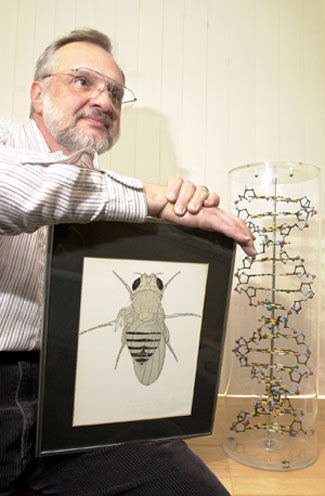Evolution at work
The tale of a tail – New gene found in fruit flies could impact human medicine
Most people don’t think of evolution as very dynamic. If they think of it at all, they see it as something that happened in the deep past. But all species possess chromosomes, coiled strands of genes in every one of their cells, and these genes are constantly changing.
Take fruit flies, for example. These flying specks of life have been buzzing around overripe fruit for some 2 million years, and they are still evolving. Or at least their sperm tails are.
Harvard researchers discovered this fact accidentally, and their subsequent investigation of it could lead to a way to detect evolving genes in all species, including humans. Besides satisfying scientific curiosity, that information could have medical value.

“Our method might be used to find genes actively evolving in viruses, bacteria, and other germs that cause human disease,” explains Daniel Hartl, Higgins Professor of Biology at Harvard. “This knowledge then might be used to find new targets for drugs and other treatments.”
Hartl and his colleagues at Tufts University in Boston and the U.S. Department of Agriculture were studying so-called motor proteins in fruit-fly sperm tails. These proteins power the swimming motion that propels sperm to a docking with female eggs.
In one type of fly, Drosophilia melanogaster, but not in others, the researchers found a gene that carries instructions for making a motor that gives this species’ sperm extra horsepower. The researchers were not looking specifically for such a gene but came across it serendipitously during a general investigation of motor proteins.
Various creatures boast these proteins, which make it possible for them to get around in salt water or fresh water, or in a reproductive canal, by lashing or spinning threadlike tails. “The tail of D. melanogaster‘s sperm is twice as long as the fly itself,” Hartl points out. “Other fruit flies may have tails as long as 20 times their body length, intricately coiled inside their sex organs until ready for use. We have no idea why they grow so long.”
A reversal of roles
Finding a gene with instructions for making such a protein promised the possibility of a view into a corner of evolution that no one had seen before. Upon looking into it, the biologists found that D. melanogaster evolved a new gene that none of its relatives had. The new gene fused two old genes together. A gene region that once carried a code or blueprint for making a protein became an on-off switch, and a region that didn’t code for anything now carries blueprints for making part of a sperm-tail motor.
“It’s a beautiful reversal of roles,” Hartl comments. “It shows that a gene’s function is not necessary fixed but can evolve to do something quite new.”
Originally, the new gene probably gave fruit flies that had it an advantage over those who did not. Sperm motility would have helped them in nature’s most basic competitive race – reproduction. Now, all males have it, so the advantage is less.
But the story is not over. The gene is still actively undergoing evolutionary improvement.
When a favorable shift like this occurs, it changes the whole neighborhood of the chromosome where it happened. Molecular biologists can easily see the upheaval with newly available methods of gene mapping. For example, if the neighborhood is an old one, researchers see many signs of change, i.e., different variations among individual flies. But in a newly rebuilt chromosomal neighborhood, little variation exists. The latter is what Hartl and his colleagues see in the area of the new sperm-tail gene.
“By carefully studying genetic variation along chromosomes, we’re reasonably certain we can detect which genes are actively evolving in any species, including humans,” Hartl says. “That information can be used to find these genes in viruses and other organisms that cause disease. Such a search might reveal vulnerable sites that we could target with new kinds of drugs.”
Human gene activity
Humans possess a gene that appears to be distantly related to the new sperm-tail gene in D. melanogaster. This gene may not be actively evolving, but other human genes are. For example, a recently mutated gene that has swept through Africa makes people resistant to one type of malaria. The gene prevents a parasite called Plasmodium vivax from attaching itself to liver and blood cells.
P. vivax is not a lethal strain of malaria but it makes people very sick. “It doesn’t kill you, but it makes you wish you were dead,” Hartl notes. The mutation keeps those who have it from getting sick.
Malaria kills about 1 million children per year. Most of these deaths are due to Plasmodium falciparum, which, like other strains, is transmitted by the bite of anopheles mosquitoes. Another comparatively new mutation conveys resistance to P. falciparum, but at a high price. It causes sickle cell anemia, a painful inherited blood disease that occurs mainly in blacks. Sickle cell anemia, however, is not usually fatal.
These are examples of actively evolving genes in human. A search for such evolving genes in malaria parasites might reveal new targets for better drugs or even a vaccine.
Hartl and his team are now mapping the new neighborhood of the fruit fly sperm-tail gene in hopes of learning more about how evolution works. They are also looking at other genes necessary for the male half of reproduction. “They are a particularly interesting group to study,” he says, “because in all species, including humans, they evolve faster than any other group of genes. We’d like to find out why.”




